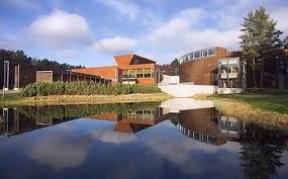Pekka Jylhä, who made
his debut in Vaasa 1984, is one of the most important Finnish sculptors. In
addition to several exhibitions, he has become known through his many public
art works. One of them is Spring (Lähde), a monument built in memory of
the late president Urho Kekkonen, was unveiled in Hakasalmi park,
Helsinki in 2000.
The current exhibition
presents mainly works from the new millennium, but also some older pieces, and a
book on Jylhä's art has been recently published by Parvs Publishing.
For Jylhä himself, the exhibition is about looking back on what has been done.
"I am not sure
whether this is the end of something, or the start of something new",
Jylhä states. "My works are always taking me in unknown directions. It is
like I am in the middle of a stream and I just have to let it take me where it
wants to go."
One of the central
themes of the exhibition is the collision between human beings and nature. A
sadly literal example is the piece Revelation (Ilmestys, 2000),
which presents a golden deer situated on a cliff beside a motorway. Clear conscience (Puhdas omatunto,
2007) shows another way people today are used to confronting animals: as
objectified goods. This piece brings together an expensive looking crystal
chain and economically worthless bunny. The financially oriented world
suffocates the bunny, conquers its living environment.
The white bunny is a
recurrent element in Jylhä's art works and it seems to speak strongly to many
viewers. Perhaps it reminds us of the vulnerability of people as well.
“The only means for the
bunny to survive in this hard world, is being scared and staying on guard all
the time”, Jylhä says.
{mosimage}In many works the bunny
confronts big questions, but it always stays faithful to who it is: a timid
little creature, willing to understand and do its best. Perhaps the most
impressive piece with the white bunny, Lantern bearer (Lyhdyn kantaja,
1999-2000), occupies a whole room. The little bunny stands lit in the middle of
a dark room holding a mirror ball that reflects a rotating night sky. The
innocent little animal is holding an entire world on top of its nose, but it is
proud and confident.
Jylhä explains that
through his works he tries to tell stories that have touched him. The
autobiographical content has an important role in his work. The small rocking
chair, This side that side (Täällä puolen tuolla puolen,
1994), is based on a childhood experience: the nine-year-old Pekka Jylhä found
his mother dead in a similar chair.
“I was the first to
arrive and the chair was still gently rocking”, he states. “I wanted to make a
rocking chair that would never come to a halt.”
This side that side, with its everlasting movement, reminds us of
the preserving qualities of art, which become important in many artists' work.
For example, the most famous Shakespeare sonnet, Shall I compare thee to a
Summers day, is about the fading beauty of the beloved, which only the
eternal lines of a poem can preserve. Jylhä however, has a more humble view on
the matter:
"In this world,
nothing that was made by man is permanent, and that is probably for the
best", he concludes.
Jylhä continues by saying
that the autobiographical elements are a way of returning to experiences that
may have been forgotten, but are still present in him, and may even have been passed
on to his children.
Many of the works deal
with the big questions of life and in some instances, even give an impression
of a religious atmosphere. According to Jylhä, a lot of this experience is due
to the materials he uses:
“I try to use materials
that are pure and therefore naturally reveal a sacral impression. The symbolism
that comes with the materials is very central in my works.”
The choice of materials
such as water, crystal and stuffed animals; the use of light, living fire and the
colour white, create a very northern atmosphere. Walking in the museum feels
like walking in a wintry Finnish forest: ice and snow sparkling like diamonds
in the pale light of a frosty winter day. For a Finn the forest is like a
church: a peaceful and holy environment. Through Pekka Jylhä's work, the
peaceful harmony of the forest is passed on to the museum space.
